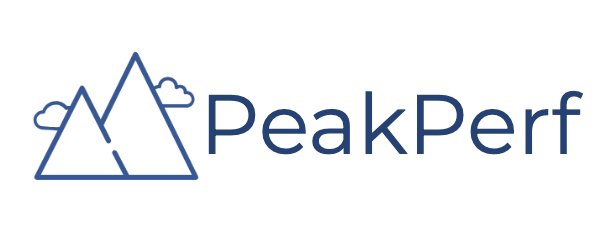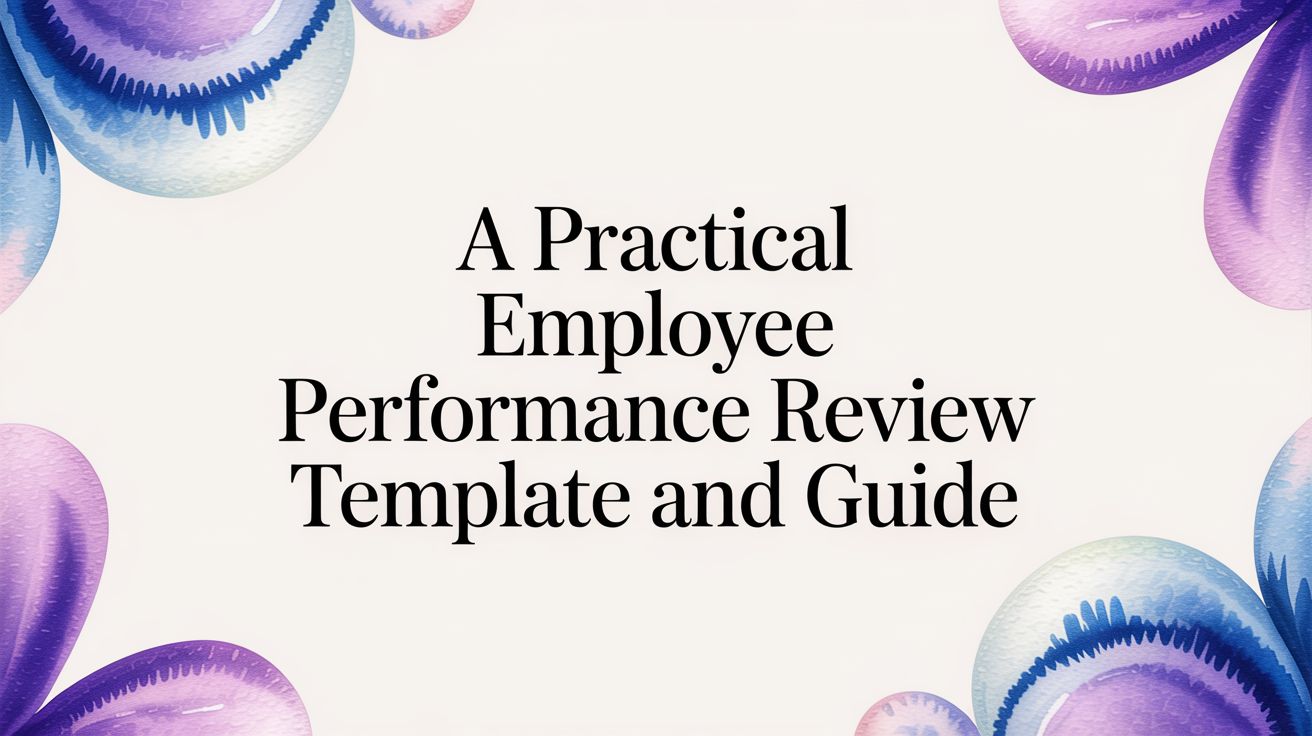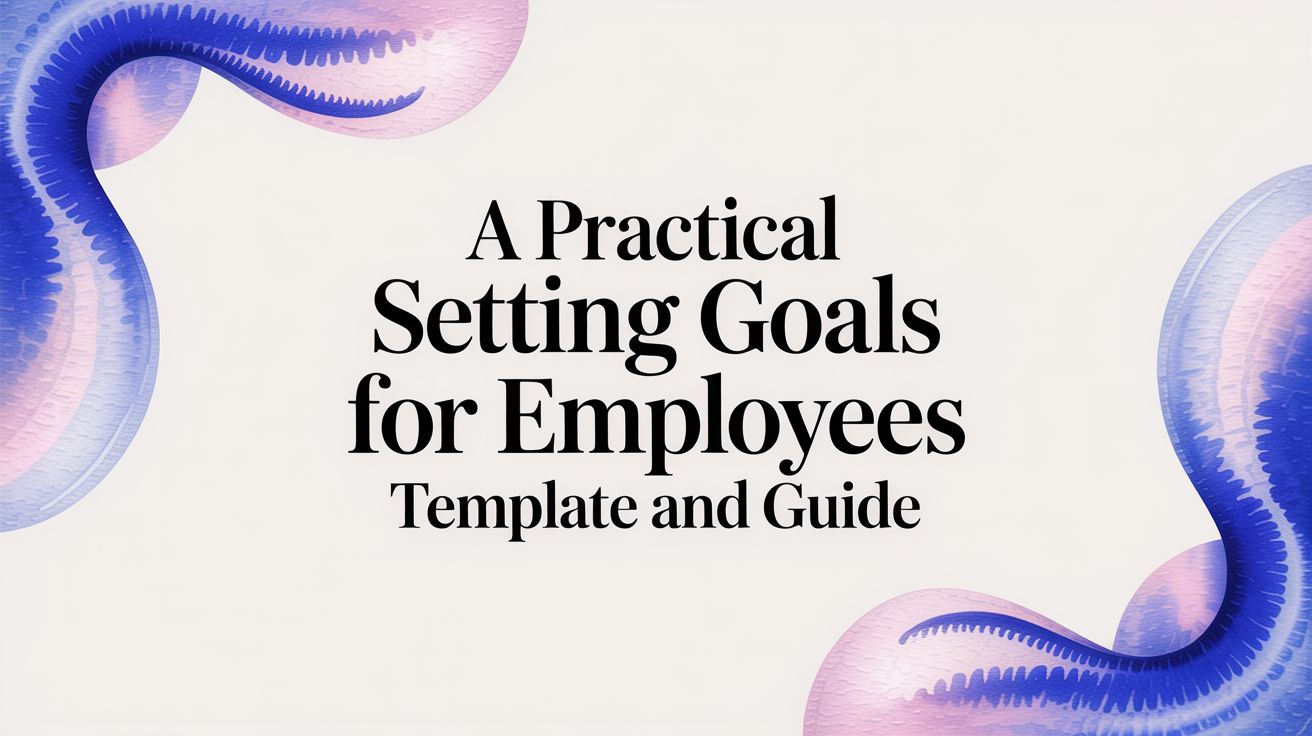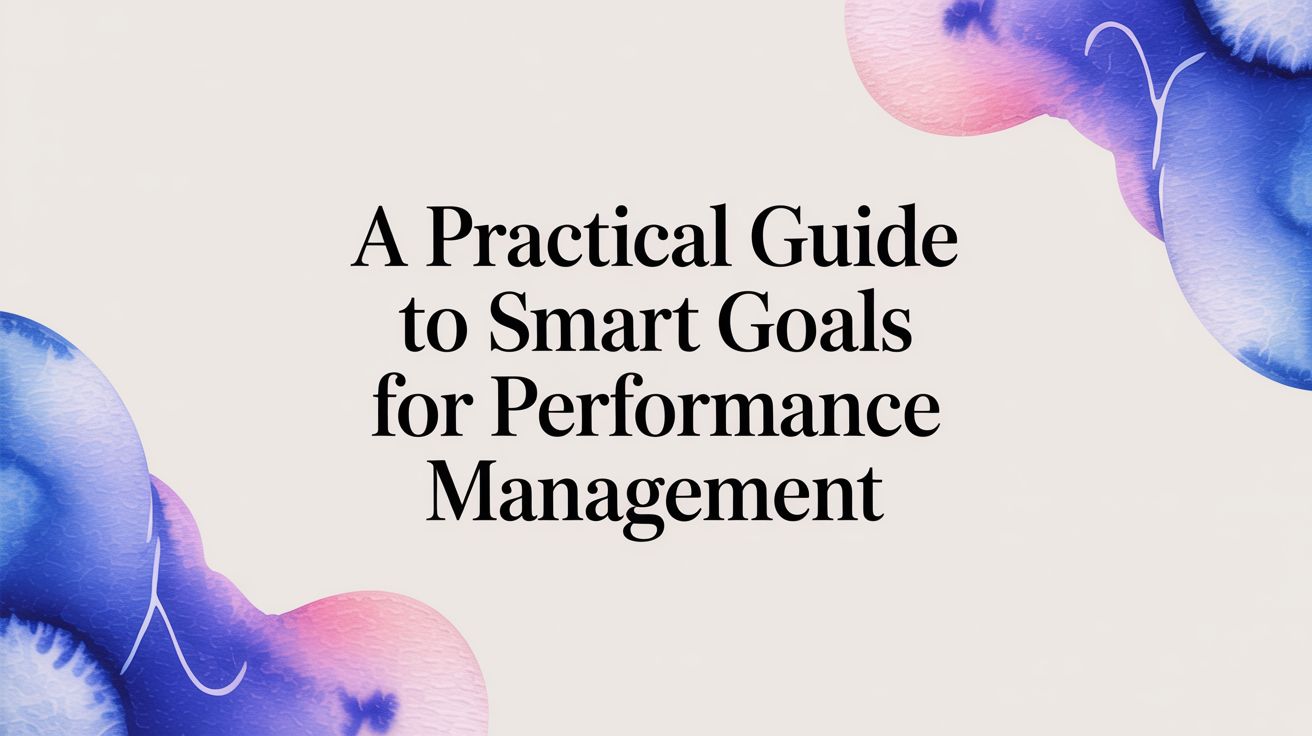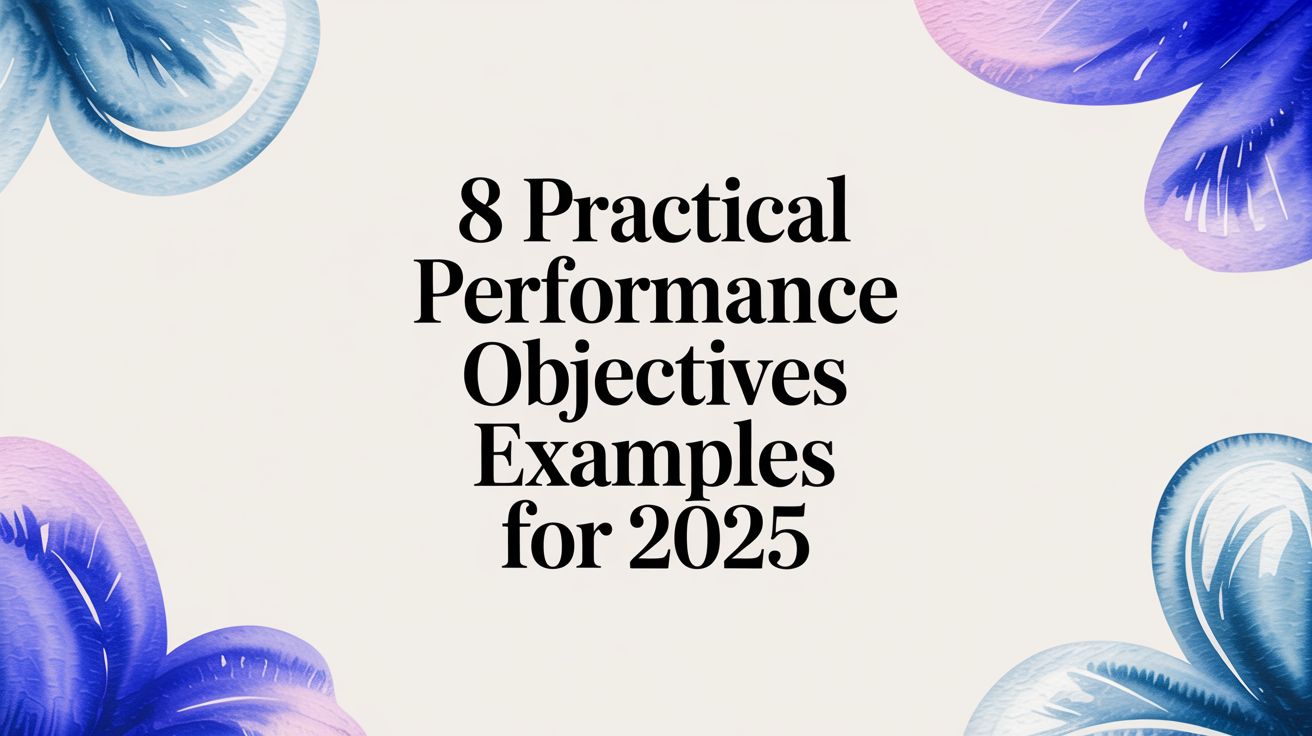A Performance Review Template for Managers That Works
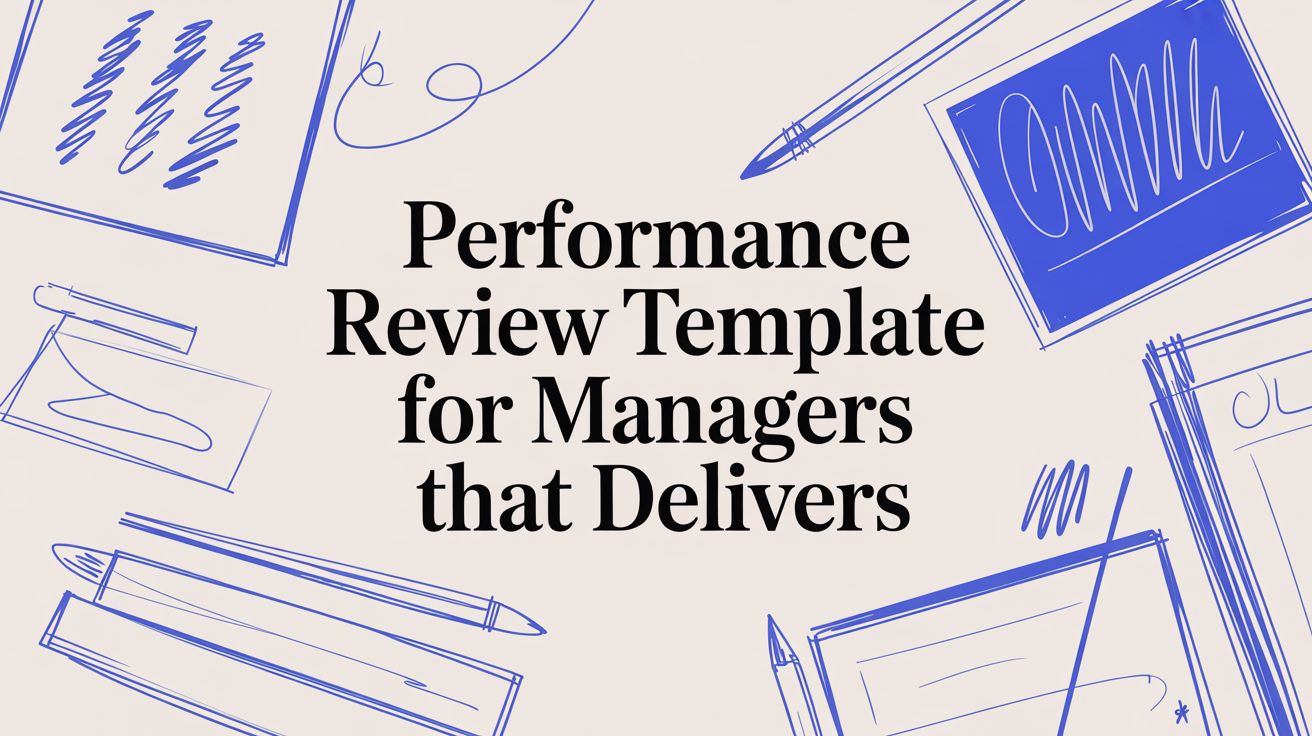
A good performance review template gives you a solid framework to evaluate your team. It is a tool that helps you deliver feedback that is consistent, fair, and constructive. By outlining key areas like goals, competencies, and development paths, a strong template turns a difficult meeting into a productive, two-way conversation.
Why Old Performance Reviews Harm Your Team
Traditional annual reviews often feel like a chore. Managers scramble to recall an entire year's worth of work, while employees brace for criticism. This outdated model damages team morale and engagement. It creates a yearly cycle of anxiety and mistrust, undermining the point of performance management.
The biggest problem is timing. When you save all feedback for one yearly meeting, it loses its impact. Employees get blindsided by critiques about mistakes that happened months ago. This leaves them feeling defensive and confused, wondering why nobody mentioned it when they had a chance to fix it.
The Challenge of Recency Bias
One of the most glaring flaws of the annual review is recency bias. People naturally give more weight to recent events. As a manager, you are more likely to remember a project that wrapped up last week than a big win from ten months ago.
This tunnel vision skews the evaluation. An employee who performed well for most of the year but fumbled a recent project might receive an unfairly negative review. A mediocre performer who nailed a high-profile task right before review season could get overvalued. The result is an assessment that is inaccurate and unfair to their contribution over the entire year.
This graphic shows how widespread the dissatisfaction is with these old-school review methods.
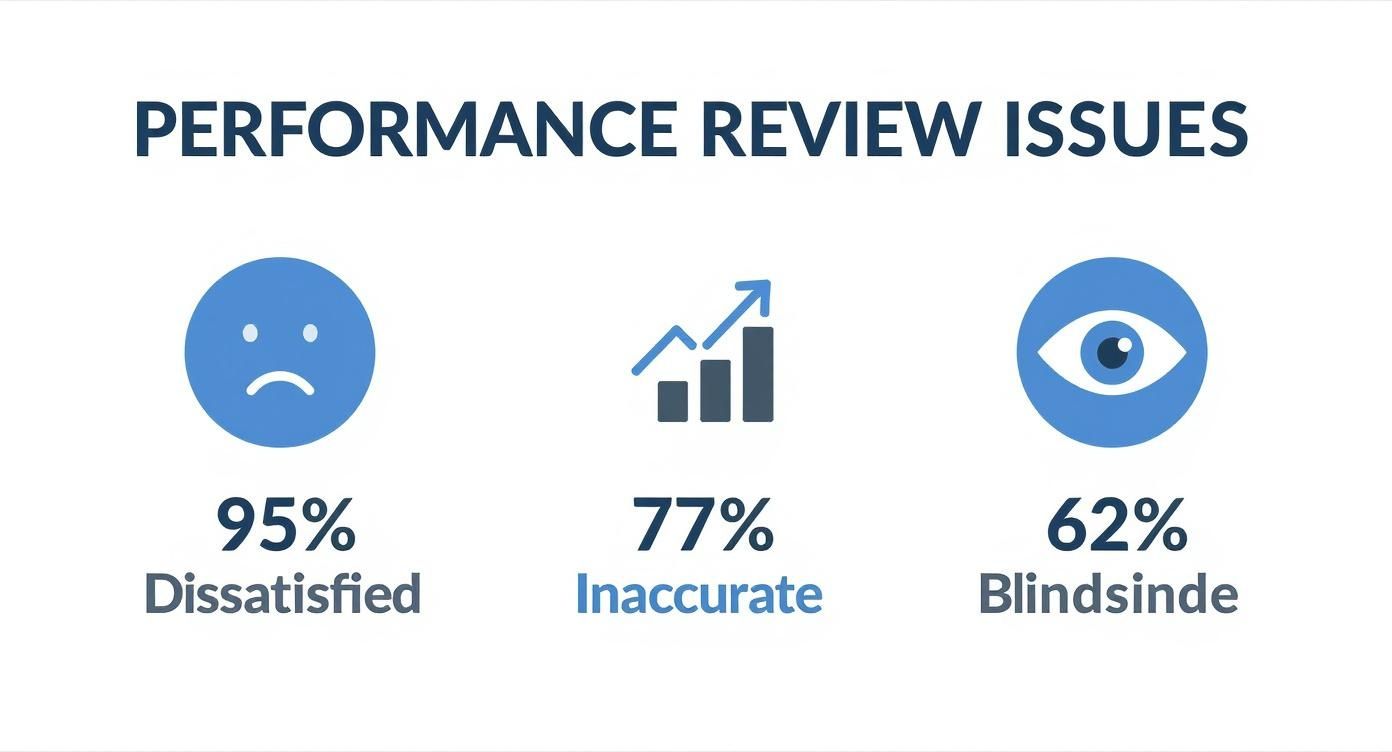
The data is clear. The overwhelming majority of HR leaders and employees agree these systems are broken and do not paint an accurate picture of performance.
Disengagement and Missed Opportunities
Infrequent feedback creates a vacuum where employees feel disconnected from their goals and from you. Without regular check-ins, they guess if they are on the right track. That uncertainty leads to disengagement. People will not go the extra mile when they feel their efforts will not be noticed until one high-stakes meeting.
By shifting to a model of continuous feedback, you replace the annual surprise moment with ongoing coaching. This builds trust and empowers employees to own their development in real time.
The numbers support this. As of 2025, 95% of HR managers were unhappy with their company’s performance systems. Around 77% of HR leaders felt that annual reviews do not reflect an employee's day-to-day work. About 62% of millennials said they felt blindsided by their evaluations.
This feedback gap is a major driver of low morale and turnover. You can learn how to build a more supportive system by exploring modern performance management best practices.
Grab Your Free Performance Review Templates
Most performance reviews are a missed opportunity. They feel like a one-sided lecture or a box-ticking exercise. A good template changes that. It provides a roadmap for a genuine, two-way conversation about growth, turning a difficult meeting into a productive one. It is the shared script you and your employee use to get on the same page.
I have put together several downloadable and editable templates to get you started. Pick the one that feels right for your team and your company's culture. They are designed to be simple and clear, so you can spend less time on formatting and more time on the conversation.

Here are three distinct versions you can download and use right away. Each one comes in both Google Docs and Microsoft Word formats, so editing and sharing is easy.
- Standard Performance Review Template: Your go-to for most roles. It is a solid, all-around option that covers core competencies, goal progress, and future development.
- Project-Based Review Template: Perfect for teams that work in sprints or on specific, time-sensitive projects. The focus here is on project contributions, teamwork, and hitting key outcomes.
- Skills-Focused Development Template: Use this when an employee is focused on professional growth. It is built to guide conversations around skill-building, leveling up competencies, and mapping out a career path.
What Makes a Good Template?
Before you download, let's unpack what makes a modern performance review template work. The goal is not to rate performance. The goal is to gather specific, balanced feedback that helps someone understand their impact and see a clear path forward. A great document tells the story of an employee's journey, not just their final grade.
Think of it less as a form and more as a tool for a meaningful dialogue. The structure prompts you to find concrete examples, consider different angles, and connect individual goals to what the team is trying to accomplish. This prep work separates a helpful review from a frustrating one.
Here is a look at the essential sections in our templates. Knowing why each part is there will help you get the most out of the document, both in your prep and in the meeting itself.
Template Key Components and Purpose
This table breaks down the core sections of a modern review template and explains the goal behind each one.
| Template Section | Purpose and Focus | Example Question |
|---|---|---|
| Goal Achievement | Objectively assess progress against predefined goals set during the previous review period. This section uses specific metrics and outcomes. | What progress did you make toward your Q2 goal of increasing customer retention by 10%? |
| Core Competencies | Evaluate behaviors and skills essential to the role and company culture, such as communication, teamwork, and problem-solving. | Provide an example of a situation where you demonstrated strong collaboration skills. |
| Major Accomplishments | Highlight significant wins and contributions. This section allows the employee to showcase their best work and feel recognized. | What project or achievement from the last six months are you most proud of? |
| Strengths | Identify and discuss the employee's key talents and what they do exceptionally well. The focus is on leveraging these strengths further. | Which of your skills do you feel had the biggest positive impact on the team this quarter? |
| Development Areas | Constructively address areas for growth and improvement. This part frames challenges as opportunities for skill development. | What new skill or knowledge would help you overcome recent challenges in your role? |
| Future Goals & Aspirations | Collaboratively set clear, measurable, and ambitious goals for the next review period. This aligns personal growth with company needs. | What are two professional goals you want to achieve in the next six months? |
This structure ensures you get a complete picture. One that celebrates wins while also carving out a clear path for growth.
The most effective performance reviews are forward-looking conversations, not backward-looking judgments. A great template facilitates this by focusing equally on past achievements and future development.
With these pieces in place, the review stops being a report card and becomes a roadmap. It documents what happened, but it also charts a course for what comes next. Now you are ready to grab your templates and start prepping for a more impactful conversation.
Download Your Templates Here:
Preparing for a Successful Review Meeting
A great review is a summary of a conversation that has been happening all year. When you walk into that room prepared, the entire dynamic shifts. It stops feeling like a judgment and becomes a genuine, constructive dialogue. Good prep work helps you deliver fair, balanced feedback and build trust with your team.
The process starts with gathering specific, concrete evidence of an employee’s work. This is not about what happened last week. It is about collecting examples throughout the entire review period. It is the only way to avoid recency bias, where a recent stumble overshadows six months of great work. I have found that keeping a simple running document or a dedicated folder for each person is the easiest way to track these milestones as they happen.
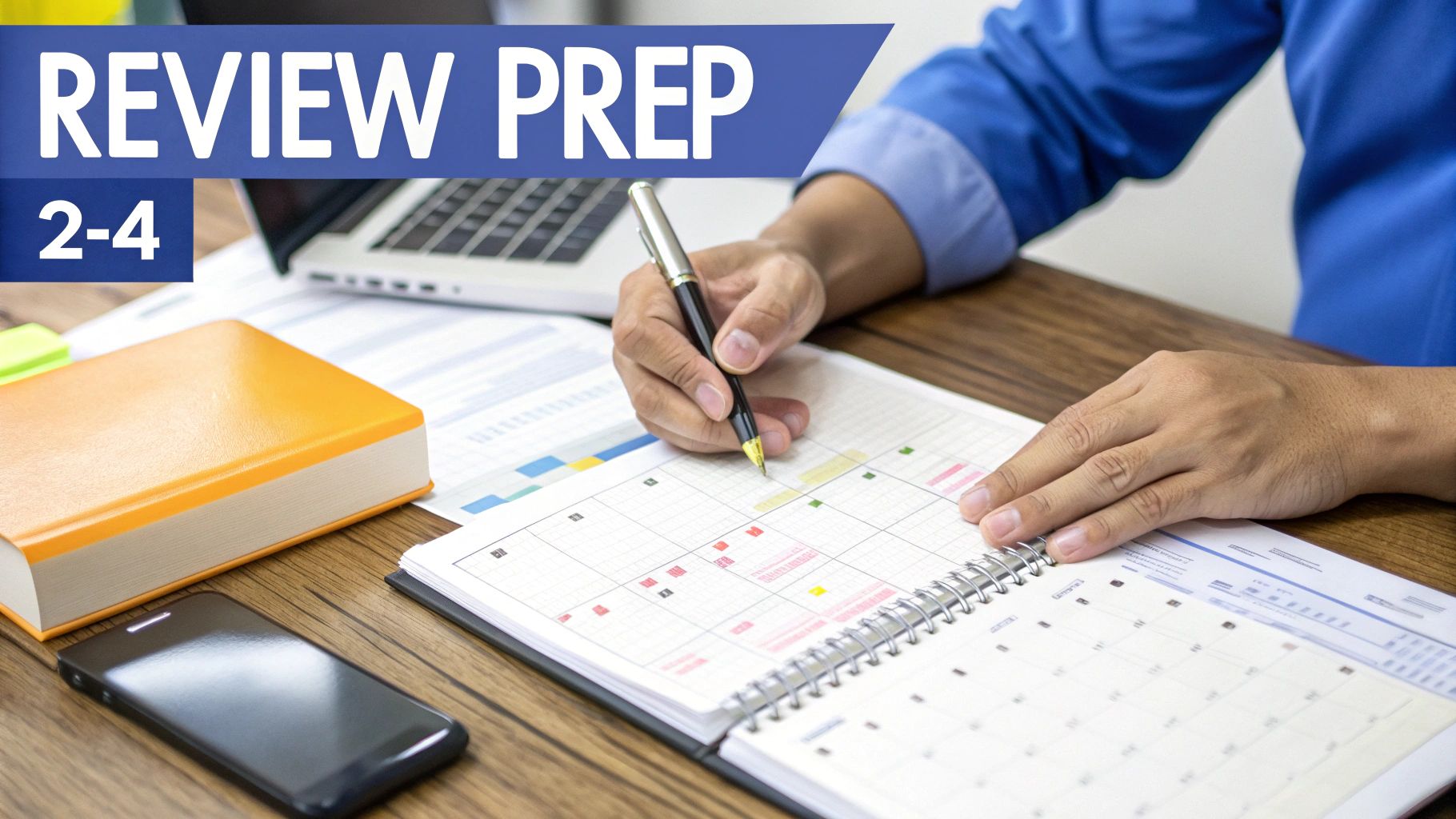
Gather Specific Examples of Work
Your feedback has more weight when it is tied to real-world situations. "You're a great communicator" is nice, but forgettable. "Your presentation on the Q2 marketing results was brilliant because you made complex data easy for everyone to understand" is feedback someone can learn from. Specificity makes praise meaningful and critiques actionable.
Pull from these sources:
- Project outcomes. Look at the finished product. Did they hit their deadlines? Did they stay on budget? Was the quality present?
- Emails and communications. A search in Slack or your email can uncover examples of professionalism, sharp problem-solving, or great collaboration.
- Customer feedback. If it is a customer-facing role, find any compliments or complaints. These often highlight clear performance trends you might have missed.
- Self-assessment. Always ask the employee to complete a self-evaluation. It is a goldmine for understanding their perspective on their own wins and roadblocks.
This level of detail takes consistent effort. We break down how to build these habits in our guide on performance management training for managers, which has strategies for making feedback collection a seamless part of your regular routine.
Collect Well-Rounded 360-Degree Feedback
Your view as a manager is critical, but it is one piece of the puzzle. Getting feedback from peers and collaborators gives you a fuller picture, especially with teamwork and influence. This is 360-degree feedback.
We still rely heavily on the manager's view. Data from 2025 shows that nearly 67% of evaluations are based mainly on what a manager observes, while only 17% include comprehensive feedback from peers. This puts a ton of pressure on you to get it right.
To get useful peer feedback, ask specific, targeted questions. Do not ask, "How is it working with Jane?" You will get vague answers.
Instead, try questions like these:
- "Can you share an example of when John demonstrated strong collaboration on the recent project?"
- "Describe a time when Sarah helped you or someone else on the team solve a tough problem."
- "What is one thing Alex does that has a positive impact on the team's morale?"
This approach gets you tangible behaviors to discuss, moving the conversation away from general feelings and into specific, impactful actions. It is a great way to uncover strengths or challenges you might not see from your position.
A great review is a summary of a conversation that has been happening all year long. Preparation is not about finding surprises; it is about organizing and presenting consistent feedback in a structured way.
Write Clear and Constructive Comments
You have gathered all your notes and data. Now it is time to fill out the performance review template. The goal here is to be clear, direct, and focused on growth.
I have found this simple three-part structure works best for writing comments:
- The Situation. Start by setting the scene. Briefly describe the project or context you are talking about to ground the feedback in a specific moment.
- The Behavior. Next, detail the exact action the employee took. Stick to what you can observe, what they did or said, not what you think they were feeling or intending.
- The Impact. Finally, connect that action to a result. Explain how it helped the team, moved a project forward, or where the outcome fell short of the goal.
Using this model keeps the feedback objective and makes someone less likely to get defensive. The entire conversation becomes about actions and outcomes, things an employee can control and change. With this groundwork done, you are set up for a productive meeting.
Leading a Constructive Review Conversation
You have done all the prep work. Now it is time to sit down and have a conversation that helps your employee grow. This meeting is your chance to turn all that feedback into real, tangible progress. It is about shifting from an assessment to a collaborative discussion about what is next. Get this right, and you will build trust and motivate your team members.
Your main goal here is to create a space where the employee feels heard, not judged. When people feel psychologically safe, they are more open to hearing tough feedback and brainstorming solutions. That is the foundation for a productive, forward-looking talk.

Structuring the Meeting for Success
A little structure goes a long way. It keeps the meeting on track, ensures you cover all your bases, and helps manage the emotional temperature of the room. Without a clear flow, the conversation can become a one-sided monologue.
Always start on a positive, welcoming note. I like to start by quickly running through the agenda so they know what to expect. It is a simple step, but it immediately reduces anxiety and puts you both on the same page.
Here is a simple flow that works:
- Open with the Wins: Start by highlighting a few key accomplishments or strengths. This sets a positive tone and shows you are paying attention to their contributions.
- Hand Over the Mic: Ask the employee to walk you through their self-assessment first. This gives them a voice early in the process and offers you crucial insight into their perspective.
- Share Your Feedback: Now it is your turn. Present your feedback, tying it directly to the specific examples you gathered. Cover both the high points and the areas for development.
- Build Goals Together: This part has to be a collaboration. Work with them to set clear, measurable goals for the next review cycle.
- End Looking Forward: Wrap up by summarizing the key takeaways. Reiterate your confidence in their ability to grow and make sure everyone is clear on the next steps.
Giving Feedback That Resonates
How you say something is as important as what you say. Vague comments like "be more proactive" are useless. People need concrete, behavior-focused feedback they can act on. This is where the Situation-Behavior-Impact (SBI) model is your best friend.
This framework strips the judgment out of feedback and focuses on what happened and what the result was. It helps prevent the defensiveness that often derails these conversations.
The goal of feedback is not to criticize; it is to build awareness. When someone understands the direct impact of their actions, they are empowered to make a change.
Let's see SBI in action. Instead of that fuzzy "be more proactive" comment, you could say:
- Situation: "During the launch planning for Project Titan last month..."
- Behavior: "...you spotted a potential scheduling conflict with the engineering team and flagged it before it became a problem."
- Impact: "...which saved us at least a week of delays and kept the whole project on track. That kind of foresight is incredibly valuable to the team."
See the difference? It is specific, positive, and reinforces what you want to see more of. It works well for constructive feedback too. For more information, check out our guide on how to give feedback to employees.
Encouraging a Two-Way Dialogue
A performance review should feel like a conversation, not a courtroom sentencing. Your job is to guide the discussion, but their voice is just as critical. When you encourage them to speak openly, you often get the missing context behind a situation.
Active listening is your superpower here. Pay full attention to what they are saying, not just waiting for your turn to talk. Use open-ended questions to get them to expand on their thoughts.
Try a few of these prompts to get the dialogue flowing:
- "What are your thoughts on that?"
- "Walk me through how you felt about that project."
- "What are some of the biggest challenges you're running into?"
- "What support do you need from me to hit that goal?"
These questions signal that you value their perspective. This collaborative spirit builds a solid working relationship and gives the employee real ownership over their development.
Handling Difficult Conversations
Sooner or later, you will have to tackle a significant performance issue. It is never easy, but dodging it lets the problem get worse. This is where your preparation pays off. Stick to your specific examples and use the SBI model to keep the conversation grounded in facts, not feelings.
Keep your tone calm and professional, even if things get emotional. You can acknowledge their feelings ("I can see this is difficult to hear") without backing down from the core issue. The objective is to get them to agree that a problem exists and then work together on a plan to fix it. Always close by confirming your support and scheduling a follow-up to check in on their progress.
How to Customize Your Review Template
A standard performance review template is a decent place to start, but it is a start. If you treat it like a one-size-fits-all document, you are missing the entire point. The magic happens when you customize it. You have to mold that template to fit the realities of each role, the person’s place in the company, and your company's culture.
You would not evaluate a software engineer and a graphic designer using the same scorecard. One person’s success is measured in clean code and system efficiency. The other’s is measured by creativity and visual storytelling. Using the same generic criteria for both is unfair.
When you take the time to adapt a template, you send a clear message: "I see you, and I understand what your job entails." It transforms the review from a bureaucratic chore into a meaningful conversation about their specific contributions and where they can go next.
Tailoring for Different Roles and Responsibilities
First, you have to tweak the evaluation criteria based on the job. A universal list of competencies rarely captures what makes someone great in a specialized role. Your performance review template for managers has to be flexible enough for this.
Here is how you might adjust for different functions:
- Technical Roles (Engineers, Data Analysts): Focus on criteria like code quality, problem-solving skills, and system knowledge. Their work is about precision and tangible outputs.
- Creative Roles (Designers, Writers): Shift the focus to things like innovation, originality, and the ability to turn a vague concept into something compelling. Success here is often more subjective, but it is no less critical.
The same logic applies as people climb the career ladder. What you expect from an individual contributor is different from what you need from a team lead.
- Individual Contributors: Keep the review focused on task execution, skill development, and their direct impact on team goals. It is about their work product.
- Team Leads: Now you are evaluating their ability to mentor, manage projects, and delegate effectively. Their success is measured by the team's collective output and morale.
Adjusting for Work Environment and Company Culture
Where your team works matters too. A fully remote employee needs a different set of skills to thrive compared to someone in the office five days a week. Your template needs to reflect that reality.
For your remote employees, you might add sections on:
- Proactive Communication: How well do they keep everyone in the loop without you chasing them down?
- Autonomy and Time Management: Can they own their workload and hit deadlines without supervision?
- Digital Collaboration: Are they fluent in the tools your team uses to stay connected and get things done?
Do not forget your company culture. The tone of the review has to match the way you operate. A formal corporation needs a different feel than a laid-back startup. If your culture is conversational, make the template's language match. A friendly tone can make feedback easier to hear. A more formal one might be necessary to signal the gravity of a serious performance issue.
Your template is a living document. It should evolve with your team, your company, and the changing demands of the work. Regular adjustments ensure it remains a relevant tool for growth.
The shift to flexible work is pushing this need for adaptable tools. With hybrid and remote workforces expected to hit 27.5% by 2028, companies are being forced to adopt more flexible digital performance templates. Cloud-based management tools are quickly becoming the norm, projected to grab about 65% market share by the end of 2025 as enterprise adoption of digital systems reaches 78%.
You can read more about these performance management trends and see how they are shaping the future of work. It proves how crucial it is to have a dynamic, customizable review process in place.
Common Questions About Performance Reviews
Even with the perfect template, you will have questions. As a manager, you run into the same tricky situations again and again. An employee might disagree with their review. You might need to figure out how often you should have these conversations.
Having clear, simple answers ready makes all the difference. It helps you navigate those moments with confidence and keep the process fair for everyone.
Think of this as your quick-reference guide for the tough spots.
How Often Should I Do Performance Reviews?
There is a reason the classic annual review is dying. Waiting a full year to give meaningful feedback is like navigating with a map that is 12 months out of date. By the time you have the conversation, the feedback is stale, and small, fixable issues have had too much time to grow.
Today, it is about more frequent, less formal check-ins.
Most high-performing teams I have worked with use a healthy mix:
- Formal reviews happen quarterly or bi-annually. This is your chance for a documented, big-picture conversation. It keeps goals fresh and ensures you and your report are always aligned.
- Informal check-ins happen monthly. These are lighter, one-on-one meetings. Use this time to talk about progress, clear roadblocks, and offer real-time coaching.
This rhythm eliminates surprises. When you sit down for the formal review, it should feel like a summary of conversations you have been having all along.
What if an Employee Disagrees With Their Review?
First, do not panic. A disagreement is not a sign of failure. It can be a gift, an open door to a deeper conversation that uncovers a misunderstanding. The key is to stay calm, professional, and genuinely curious about their perspective.
Your first move? Just listen.
Give them the floor and let them explain their point of view without interrupting. People often want to feel heard. Ask open-ended questions like, "Can you walk me through how you saw that project?" or "Help me understand what I might be missing here."
Your immediate goal is not to win an argument. It is to understand where the disagreement is coming from. Be open to the idea that you do not have the full picture.
Once you have heard them out, gently bring the conversation back to the specific, behavioral examples you prepared. Feedback grounded in observable facts is harder to dispute than subjective opinions. If you are still not aligned, suggest a follow-up meeting. This gives both of you time to cool off and reflect. You can also offer to attach their written rebuttal to the official review, ensuring their perspective is on the record.
How Do I Make Sure My Reviews Are Fair and Unbiased?
Fairness is the bedrock of any good performance system. The second your team feels the process is biased, trust evaporates. Your best defense against this is to anchor every evaluation in objective evidence.
Here are a few practical ways to keep things fair:
- Use the Same Yardstick: Evaluate every employee against the same set of role-specific competencies. This is where a standardized template becomes essential.
- Get a 360-Degree View: Do not rely on your own observations. Pull in feedback from peers, collaborators, and even direct reports if it makes sense. This gives you a more complete picture and helps reduce your own biases.
- Calibrate with Other Managers: This is a big one. Sit down with your fellow managers to discuss your team’s ratings. This "calibration" meeting ensures that a "meets expectations" in your team means the same thing as it does in another.
When you use data and bring in multiple perspectives, the conversation shifts from "what I feel" to "what the evidence shows." That rigor builds the trust you need for employees to hear and act on your feedback.
Ready to make every leadership moment easier? PeakPerf gives you the tools and frameworks to prepare for performance reviews, feedback conversations, and development planning in minutes. Go from a blank page to a confident, structured draft with guided prompts and proven models. Start for free on PeakPerf.
